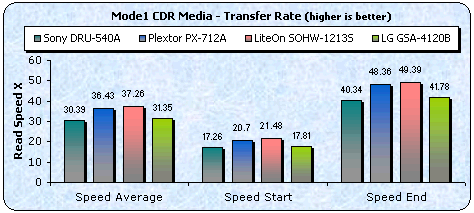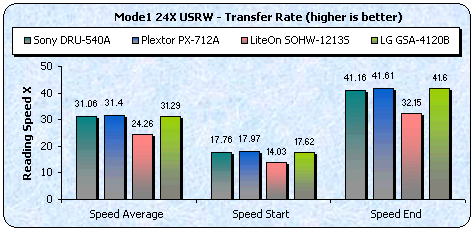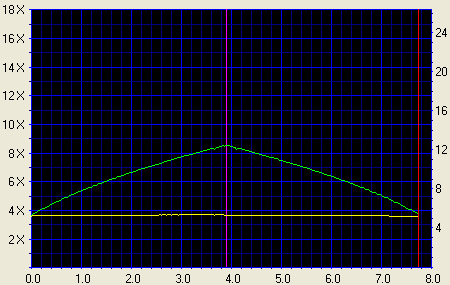Sony DRU-540A
2. Transfer Rate Reading Tests
Review Pages
2. Transfer Rate Reading Tests
3. CD Error Correction Tests
4. DVD Error Correction Tests
5. Protected Disc Tests
6. DAE Test
7. Protected AudioCDs
8. CD Recording Tests
9. Writing Quality Tests - 3T Jitter Tests
10. Writing Quality Tests - C1 / C2 Error Measurements
11. DVD Recording Tests
12. CDSpeed/PlexTools Scans - Page 1
13. CDSpeed/PlexTools Scans - Page 2
14. CDSpeed/PlexTools Scans - Page 3
15. CDSpeed/PlexTools Scans - Page 4
16. CDSpeed/PlexTools Scans - Page 5
17. BookType Setting
18. Conclusion
Transfer Rate Reading Tests
- CD Format
The Sony DRU-540A supports up to 40X reading speed for CD media. Our tests confirmed this. Below are the transfer rate graphs:



The CD reading performance of the DRU-540A is not the fastest in the comparison but this is due to the fact that the other drives in the comparison support 48X speed with CD media.
- DVD Format


The first layer of an OTP dual layer DVD-ROM is read exactly the same way as the first layer of the PTP disc we tested previously. The difference here is the reading strategy of the second layer of the disc. The beginning of the second layer is located in the outer part of the disc, so the drive starts reading from the outer tracks toward the inner part of the disc. The average reading speed was at 6.37.



The SONY drive performed well with a ripping speed of 7974Kb/s.
- Appendix
Nero CD-DVD Speed Graphs
- CD Pressed / CD-R / US-RW
- DVD Pressed SL / DVD Pressed DL / DVD-R / DVD-RW / DVD+R / DVD+RW
Review Pages
2. Transfer Rate Reading Tests
3. CD Error Correction Tests
4. DVD Error Correction Tests
5. Protected Disc Tests
6. DAE Test
7. Protected AudioCDs
8. CD Recording Tests
9. Writing Quality Tests - 3T Jitter Tests
10. Writing Quality Tests - C1 / C2 Error Measurements
11. DVD Recording Tests
12. CDSpeed/PlexTools Scans - Page 1
13. CDSpeed/PlexTools Scans - Page 2
14. CDSpeed/PlexTools Scans - Page 3
15. CDSpeed/PlexTools Scans - Page 4
16. CDSpeed/PlexTools Scans - Page 5
17. BookType Setting
18. Conclusion






















